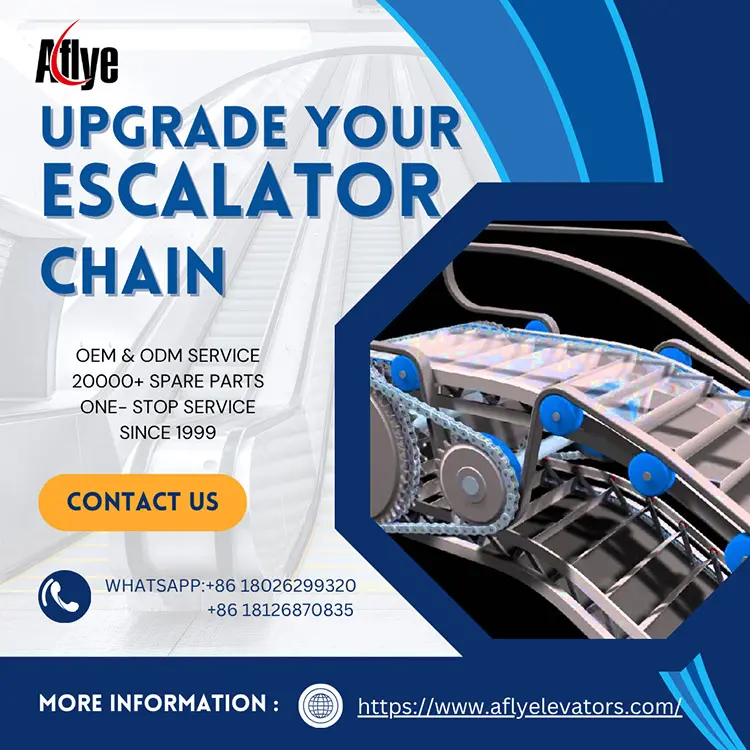How to Determine Whether an Escalator Chain Needs to Be Replaced?
In an escalator system, the escalator chain is one of the core components that bears the main load and continuously drives the step system. It operates under high load, high frequency, and high friction conditions for long periods, making it one of the fastest-wearing and most safety-critical components in an escalator. Therefore, accurately determining whether the escalator chain needs to be replaced is a key skill that every maintenance unit and building management team must master.
Today, the technical engineers from A-FLY Elevator & Escalator Parts Supplier will give you a detailed explanation of the criteria for determining escalator chain replacement.

1. Why Do Escalator Chains Wear Easily?
Escalators operate thousands of times every day, and the chain continuously bears:
- Step weight + passenger weight
- Sprocket meshing friction
- Long-term high-torque pulling force
- Dust and environmental contamination
These factors accelerate chain wear. Once a chain has issues, it may cause escalator jamming, vibration, or even serious safety hazards. Therefore, regularly inspecting and replacing the chain at the right time is essential for safe escalator operation.
2. How to Determine Whether the Escalator Chain Needs Replacement?
The following signs are typical “early warning signals” that a chain is about to fail.
1. The chain becomes significantly elongated
After long-term use, internal pins and bushings wear out, causing the chain pitch to stretch.
Once elongation exceeds the allowable limit, the chain may show:
- Rough or uneven operation
- Increased vibration
- Inaccurate step positioning
- Poor meshing with the sprocket
Chain elongation is usually the first and most critical sign that replacement is necessary.
2. Abnormal noise during chain operation
If the chain produces:
- Metal knocking sounds
- Jamming or catching sounds
- Abnormal friction noises
This may indicate:
- Worn chain links
- Loose pin bearings
- Incorrect meshing angle with the sprocket
Continuous abnormal noise is a major indication that the chain is near end-of-life.
3. Noticeable chain deviation or shaking
If the chain cannot maintain stable alignment and swings or shakes unevenly, it indicates structural deformation or severe wear.
Common causes include:
- Pin wear causing looseness
- Deformed chain plates
- Poor link engagement
At this point, chain replacement should be evaluated immediately.
4. Chain plates show cracks, deformation, or rust corrosion
After long periods in harsh environments, chains may show:
- Cracked chain plates
- Surface rust
- Metal fatigue damage
These issues cannot be repaired and require replacement.
5. Worn sprockets causing poor chain meshing
Sprocket wear accelerates chain failure.
When the sprocket no longer matches the chain, issues may include:
- Chain jumping
- Increased noise
- Unsteady operation
In such cases, both the chain and sprocket usually need replacement.
6. Total running time has reached or exceeded service life
Most escalator chains have a recommended replacement cycle of:
8–12 years (depending on environment and passenger flow)
High-load environments such as malls, metro stations, and airports may require earlier replacement.
3. What Are the Risks of Not Replacing the Chain in Time?
Failing to replace the escalator chain on time may cause:
- Sudden escalator shutdown
- Unstable step operation
- Chain breakage leading to severe accidents
- Passenger fall risks
- Equipment damage and higher repair costs
The chain is a component directly linked to passenger safety—it must never be used “until failure.”
4. A-FLY — Professional Escalator Chain Supplier
As a global leading elevator & escalator parts supplier, A-FLY provides high-quality chains suitable for multiple escalator brands, including standard and customized chain and sprocket assemblies.
A-FLY escalator chains offer:
- High-strength escalator alloy steel material
- Precision heat treatment process
- Excellent wear resistance and tensile strength
- Long service life
- High link accuracy for smoother meshing
We also provide sprockets, escalator guide rollers, and escalator step system solutions to perfectly match various escalator maintenance and modernization projects.
5. Summary: The Health of the Escalator Chain Is the Foundation of Escalator Safety
Chain wear does not happen suddenly, but danger often appears after it is ignored.
By mastering chain wear assessment methods and replacing the chain on time, you can greatly improve escalator safety, reduce maintenance costs, and extend equipment lifespan.
Choose A-FLY to make your escalators run more smoothly, last longer, and operate more safely.
A-FLY — Global supplier of critical escalator components, safeguarding safety.

